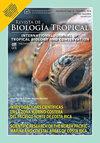Nursery-reared coral outplanting success in an upwelling-influenced area in Costa Rica
IF 0.6
4区 生物学
Q4 BIOLOGY
引用次数: 0
Abstract
Introduction: Environmental and intrinsic factors such as seawater temperature, salinity, nutrient concentration, upwelling, species, and life history can influence coral outplant survival and growth, and in consequence, the effectiveness of restoration. Thus, it is key to understand how these factors can shape coral outplant performance to ensure the long-term success of a restoration program. Objective: To establish the survival and growth rate of outplanted coral nursery-reared colonies of branching Pocillopora spp. and massive corals Pavona gigantea, Pavona clavus, and Porites lobata in Bahía Culebra, North Pacific of Costa Rica, and to determine whether the site of origin of the coral fragment and the presence of seasonal upwelling affected the growth of Pocillopora outplants. Methods: From September 2020 to September 2021, we monitored the survival, health, and growth of 30 Pocillopora spp. colonies from six donor sites, and 31 fragments of massive species (P. gigantea [n = 18], P. clavus [n = 8], P. lobata [n = 5]) that were outplanted to a degraded reef. We recorded in situ seawater temperature, salinity, and nutrient concentration. Results: By the end of the year, 100 % of the Pocillopora spp. outplants survived. Survival was 71.4 % for P. clavus, 47.5 % for P. gigantea, and 20 % for P. lobata. Coral tissue loss and predation marks were observed at least once in 71 % of massive outplants. Pocillopora spp. colonies increased their initial area in 333.1 %, at a rate of 9.98 ± 1.69 cm yr-1. The site of origin of the outplant influenced growth rate, but not the presence of seasonal upwelling. Massive species fragments grew at a rate of 1.35 ± 0.24 cm yr-1 for P. clavus, 1.48 ± 0.21 cm yr-1 for P. gigantea, and 0.61 cm yr-1 for P. lobata, with no differences among them. Conclusions: Environmental conditions at site level allow for high survival and growth of Pocillopora spp. outplants, previously considered as sensitive to stressors, and point towards acclimation to seasonal upwelling. Although survival of massive species was lower, developing a multi-species approach is key to enhance restoration success.在哥斯达黎加受上升流影响的地区,苗圃饲养的珊瑚成功外植
简介:环境和内在因素,如海水温度、盐度、营养物浓度、上升流、物种和生活史,都会影响珊瑚的存活和生长,从而影响恢复的有效性。因此,关键是要了解这些因素如何影响珊瑚的外部性能,以确保修复计划的长期成功。目的:确定哥斯达黎加北太平洋库莱布拉湾的分支Pocillopora spp.和大型珊瑚Pavona gigantea、Pavona clavus和Porites lobata的人工培育珊瑚群落的存活率和生长率,并确定珊瑚碎片的起源地和季节性上升流的存在是否影响了Pocillobora人工培育珊瑚的生长。方法:从2020年9月到2021年9月,我们监测了30个Pocillopora spp.的存活、健康和生长。来自6个供体地点的菌落,以及31个大型物种(P.gigantea[n=18]、P.clavus[n=8]、P.lobata[n=5])的片段,这些物种被移植到退化的珊瑚礁中。我们记录了现场海水温度、盐度和营养物浓度。结果:到年底,Pocillopora spp.的外株存活率为100%。棒叶P.clavus的存活率为71.4%,巨型P.gigantea的存活率47.5%,大叶P.lobata的存活率20%。71%的大型外来植物中至少观察到一次珊瑚组织损失和捕食痕迹。Pocillopora spp.菌落的初始面积增加了333.1%,增长率为9.98±1.69 cm yr-1。外部植物的起源地影响生长速率,但不影响季节性上升流的存在。大量物种碎片的生长速率分别为:棒叶P.clavus 1.35±0.24cm yr-1、巨型P.gigantea 1.48±0.21cm yr-1和大叶P.lobata 0.61 cm yr-1,两者之间没有差异。结论:现场水平的环境条件允许Pocillopora spp.的高存活率和生长。以前被认为对压力源敏感的外部植物,并指向对季节性上升流的适应。尽管大量物种的存活率较低,但开发多物种方法是提高恢复成功率的关键。
本文章由计算机程序翻译,如有差异,请以英文原文为准。
求助全文
约1分钟内获得全文
求助全文
来源期刊

Revista De Biologia Tropical
生物-生物学
CiteScore
1.80
自引率
0.00%
发文量
23
审稿时长
4-8 weeks
期刊介绍:
The Revista de Biología Tropical / International Journal of Tropical Biology and Conservation is a mainstream scientific journal published since 1953 and covered by Web of Science; Science Citation Index; Current Contents; Google Scholar; Scopus, SciELO and nearly 50 additional indices.
A double blind system guarantees you a fair evaluation, and our world class editorial and scientific boards provides a first decision in three working days. The journal is Full Open Access and is widely read where your article can have the highest real impact.
Since its beginning in 1953, the Revista follows these principles: objective and independent evaluation of all manuscripts; transparency in all processes; ethical use of procedures, data, specimens and subjects; fair treatment of all parties; and absolute predominance of scientific rigor over any other aspect.
 求助内容:
求助内容: 应助结果提醒方式:
应助结果提醒方式:


